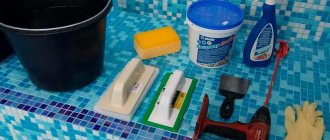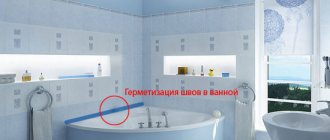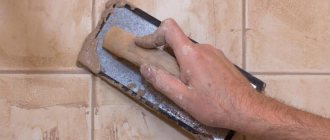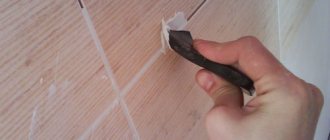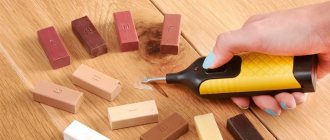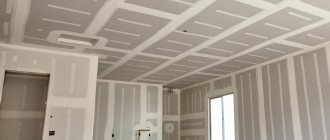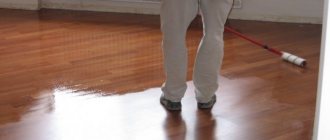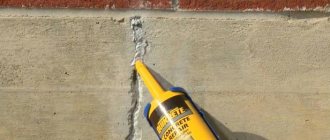We are publishing an article by our reader Evgeniy Ivanovich, an experienced builder and finishing specialist, who shares his wealth of experience. The information is intended for professionals who want to broaden their horizons and master advanced tiling techniques.
The technology has been used in practice more than once and has been time-tested for reliability. This cladding method was developed by me in the 90s. Main advantages compared to the traditional method:
- Reduced labor costs.
- Reduced weight of the structure.
- Possibility to reuse facing tiles (repeatedly).
- Creation of a heat and sound insulating air layer.
In my opinion, the limitations in using the described method are:
- floor covering;
- cladding of external surfaces in climate zones with negative temperatures;
Softened silicones, sealants and other adhesives are used as a binder, which are conveniently applied in portions to the tiles using a syringe or gun.
Adhesive sealant for seams, gray
CEMMIX Adhesive-sealant for seams is a one-component polyurethane sealant for sealing various seams, junctions of steps and walls, entry of pipes and ventilation systems and rigid-elastic gluing of various materials.
More details
How long does it take for the composition to dry?
Gradually we came to the main question: how long does silicone sealant dry? The period of its hardening very much depends on the area of application and the composition of the product itself.
Sealant polymerization time depending on type:
- Acid-based sealant takes approximately 4-6 hours to dry.
- For neutral silicone sealant to completely dry, it takes more time, about 24 hours. In addition, an important condition is positive temperature - from 5 to 40 degrees.
Depending on the area of use, the drying time of the sealant may be as follows:
- If you apply this material generously enough, its outer layer hardens and does not stick to your hands after 15 minutes. And in the inner layers at this time the polymerization process is just starting. It passes at such a speed: every 2 mm of the inner layer hardens in 24 hours.
- If the temperature in the room increases significantly, the sealant will dry twice as fast. And if you carry out outdoor work in the cold season, then the sealant should be given more time to dry.
Tip: Read what it says on the package. Usually it indicates the drying time of the sealant under certain conditions.
Sealant in the bathroom
How long does it take for sealant to dry in high humidity conditions in the bathroom? Again, this depends on the choice of product itself:
- Silicone acid sealants dry the fastest - in 4-6 hours. But such material cannot be used to work with metal structural elements to avoid corrosion of the metal.
- Neutral sealant is more versatile, but it also costs more.
Its 2 mm thick layer dries completely within a day, but the temperature should only be above zero. The most favorable range: from 5 to 40 degrees. Applying sealant to joints in the bathroom - Sanitary neutral sealant is often used in the bathroom. It contains fungicides that prevent the formation of mold on treated surfaces.
- When you seal the seam between the bathtub and the wall to which it is adjacent, the layer usually required is quite thick and wide. The time indicated on the packaging may not be enough to completely polymerize such a thickness. Craftsmen who install plumbing, as a rule, give it not 24 hours, but a little more. Most often - 2 days.
Important: Do not layer several strips of sealant in one place, otherwise the whole point of this procedure will be lost and no sealing will occur, because the layers will peel off from each other. Apply a strip of the desired thickness at once, simply pressing harder on the trigger.
Adhesive sealant for seams, brown
CEMMIX Adhesive-sealant for seams is a one-component polyurethane sealant for sealing various seams, junctions of steps and walls, entry of pipes and ventilation systems and rigid-elastic gluing of various materials.
More details
Especially often, mold occurs in various seams, which is understandable, since the flow of air there is difficult.
Therefore, reliable sealing of seams is also the prevention of mold in the apartment.
On straight sections of walls or floors lined with ceramic or other tiles, special cement-based grout mixtures (they can be colored) or epoxy compounds are used to fill the tile joints when there is strong chemical aggression or large mechanical loads.
Elastic sealing materials are used at seams between dissimilar materials or in places of possible deformations of the building (internal corners of rooms, half-wall junctions).
The seams between the bathtub and the tiles, all joints: the sink to the wall, the toilet to the floor, are usually sealed, and all openings for communications are also sealed.
However, recently craftsmen have also been using sealants for gluing tiles, as well as for filling tile seams.
Laying wall tiles in the bathroom - blogs - poremontu.ru
Laying wall tiles in the bathroom is a very important issue; the situation itself is complicated by the high humidity and temperature in this room.
I had been waiting for a long time for a vacation from work so that I could finally lay tiles in the bathroom, and I had been preparing for this very moment for a long time and bought one of the best adhesive solutions for tiles. At first I wanted to lay the tiles on a standard cement mortar, it holds up very well, but the gradual action of high humidity will quickly destroy the cement mortar and the tiles will begin to lag behind the wall. Therefore, I decided to buy a good tile adhesive so that the tiles would last for a very long time, I thought first of buying Ceresit glue, which I had to work with. This glue is very convenient to use, but it does not hold the tiles so strongly, that is, the shelf life of installing tiles on this glue is short. I consulted with tile installers, which means they recommended that I buy a one-component, high-quality silicone-based sealant. Today there are a lot of such types of sealant and, by the way, they are very inexpensive. At first I didn’t even believe that the sealant was so effective and decided to check it myself. First, I installed several ordinary square tiles in the bathroom as a test and checked them after a couple of days, the result turned out to be excellent, that is, I simply could not rip the tiles off the wall. So I recommend this sealant to everyone; the tiles stick to it very firmly or, as they say, tightly. In order to attach tiles with silicone sealant, you do not need to process, scratch and scrape the wall surface as when laying with ordinary cement mortar. The base of the wall should only be clean and dry; sealant can only be applied to dry tiles in a thin layer at 5-8 points. The tile sticks to the wall quickly, that is, you don’t need to wait a long time for the tile to set so that it doesn’t move—it’s enough to hold the tile for 5-10 seconds, lightly pressing it against the wall. The same sealant can also be used to seal all the seams of the tiles, which will be simply perfectly protected from moisture, temperature changes and even from fungus and mold. This silicone sealant is unique and multifunctional, that is, it is suitable not only for installing tiles, but also for gluing glass and porcelain. They can also be used to seal cracks in concrete, brick, as well as for sealing cracks in door and window blocks and in plaster.
To use a tube with silicone sealant, you need to cut it right above the thread, then screw in the nozzle and make a small cut of 1-2 mm. Then you insert the tube itself into a special metal gun and you can immediately start working. It is very important to work only at temperatures from +5C to 40C, and the humidity in the bathroom or kitchen should not be more than 50-60%. When you buy such a sealant, you better pay attention to the expiration date, usually it is one year, this is important.
Is it possible to use sealant for gluing tiles and grouting joints, and what is it for?
Tiles are the best choice for finishing bathroom walls and floors. For the floor, tiles made of more durable porcelain stoneware are also sometimes used.
However, in any case, this tile must be glued with something and the seams between the tiles must be filled.
Important!
The width of the joints between the tiles depends on various factors: the size and shape of the tiles, the designer’s intentions, and technical capabilities. Typically, wider joints are left for large or shaped tiles. Standard size tiles (up to 60 cm on a side) are usually laid with joints of about 6 mm wide. Seams narrower than 3 mm can be difficult to fill with grout, so they are rarely used; Seams wider than 12 mm are also usually not made, because there is a risk of cracking.
Typically, special tile adhesive is used to glue tiles. It is applied in a layer of a certain thickness, making it possible to further level the tiled surface. On the floor, tiles must be laid with cement-based adhesive so that the coating can withstand mechanical loads.
Tiles on walls are sometimes glued with sealant rather than glue.
In this case, the sealant, unlike tile adhesive, is applied to the tile in a thinner layer, so it will not be possible to further level the coating. The sealant dries quite quickly, which, on the one hand, allows you to carry out work quite quickly, on the other hand, it requires a certain skill.
Another disadvantage of gluing tiles to sealant is the high price of the latter, compared to tile adhesive.
Why use sealant to glue tiles?
The fact is that in some cases it is justified.
If the tiles are laid on a movable base or a base made of material subject to vibration due to shock loads, deformation from moisture or temperature changes (for example, wood, plasterboard, asbestos cement boards), an elastic connection is required, which cannot be provided with tile adhesive, and sealant in this regard will be appropriate, as it has the necessary elasticity.
Advantages and disadvantages of using sealant
Sealants have their strengths and weaknesses. Among the advantages:
- the composition is ready for use;
- simple method of application by squeezing from a tube;
- dries quickly;
- elastic.
Flaws:
- you cannot make mistakes during the installation process, because the sealant dries quickly;
- does not level the surface;
- when laying on a movable base, it will not be possible to apply grout;
- price.
Important! It is often said that the tiles fell off because the sealant or adhesive was unreliable. In many cases, the reason is inadequate preparation of the base. For example, there is no primer, incorrect application of the fixing agent.
Adhesive sealant for seams white
CEMMIX Adhesive-sealant for seams is a one-component polyurethane sealant for sealing various seams, junctions of steps and walls, entry of pipes and ventilation systems and rigid-elastic gluing of various materials.
More details
What factors complicate the joining of tiles and laminate
Depending on the layout of the rooms and the creative idea, the junction of two flooring materials may need to be made in different places. In the case of a classic design of rooms with doors, tiles and laminate will meet exactly under the door frame, which most often needs to be covered with a decorative threshold.
It is more difficult to design a joint over a large area, as is often the case in a studio apartment. There are no partitions that clearly separate the kitchen from other rooms, so the division into zones is done conditionally along the line on the floor connecting the two coverings. The challenge is to make it harmonious with other interior elements and practical for cleaning and movement of users.
Various flooring heights
The joint between tile and laminate is more difficult to create beautifully if there are different heights of the floor coverings. For example, the tiles are 8-10 mm thick and are laid with tile adhesive, which creates a floor height of 12-14 mm. A durable laminate for flooring has a thickness of 8 mm, so even using a special underlay it is impossible to bring the level to the same value.
The difference in the joints may be inconvenient for the passage of the area and collect debris. Bringing the laminate level only at the joint will help the floor rise smoothly, but in this place it will play under load. Therefore, a more stretched screed is made under the laminate to even out the difference and create a solid base under the coating.
Hygroscopicity of laminate
Another difficulty when joining laminate to tiles is the hygroscopicity of the laminate, which affects its structure. If the laminate absorbs moisture, it will swell and become looser. To avoid this, first lay the tiles and let the glue dry. Then the joints of the laminate strips are treated with a sealant that seals the areas to absorb moisture.
Changing linear dimensions
Sometimes the problem is that the physical and mechanical properties of the laminate change in size under the influence of different temperatures and air humidity. If the fit to the tile is very tight, this can cause swelling or other deformations. To prevent this phenomenon, it is necessary to create a small gap that provides freedom for expansion.
Material cutting
A common difficulty when joining tiles and laminate flooring is line alignment. Often in these places defects are visible due to sloppy cutting. In the case of short joints under doors, this is covered with a threshold.
In a large space in a studio apartment, it is important to use an electric jigsaw for laminate flooring, a grinder with a diamond blade for tiles, and a prepared template for making the cut. This will promote evenness and identity of the lines, especially with a wavy seam configuration.
Adhesive sealant for seams black
CEMMIX Adhesive-sealant for seams is a one-component polyurethane sealant for sealing various seams, junctions of steps and walls, entry of pipes and ventilation systems and rigid-elastic gluing of various materials.
More details
How to apply it correctly?
Installing laminate flooring using a good sealant is easy and creates a good seal.
Operating procedure:
- The areas where the substance is applied are thoroughly wiped and cleaned; there should be no small mechanical particles or dust on them.
- The seam is coated with an even layer on the intended area.
- Before “setting”, the laminate strip is placed in the groove of the lamella of the row that was there before, then it is carefully pressed and closed.
- The composition covers the side of the panel.
- After a couple of tens of minutes, the excess dried “burrs” are removed.
It is convenient to seal the gaps that inevitably arise during installation work with sealant.
Procedure:
- Preparing the site where work will take place.
- Applying tape in the places where work will be carried out.
- The recess is filled with substance.
- Residues along the edges are leveled; this should be done a few minutes after applying the substance.
- The protective tape is removed.
Half an hour after the start of the operation, use a damp cloth to remove any remaining sealant. In this way, you can treat not only the coating, but also, for example, repair a chip on the floor or a seam on the tile.
Adhesive sealant for seams, gray
CEMMIX Adhesive-sealant for seams is a one-component polyurethane sealant for sealing various seams, junctions of steps and walls, entry of pipes and ventilation systems and rigid-elastic gluing of various materials.
More details
Methods of docking without a threshold
When joining tiles and laminate flooring without a threshold, you first need to solve the problem of height difference: due to the adhesive layer, the tile can be higher. Only after this can you start working. Also, the joint will look good if it is carefully processed, the gap will be even.
This is how you can neatly arrange the connection between tiles and laminate
If two different materials are joined - ceramics and laminate - they cannot be placed close to each other without a gap. When temperature or humidity changes, they can increase in size (laminate suffers more from this). The presence of a gap prevents the problem - it allows it to change in size without compromising the integrity of the coating. When joining laminate and tiles without a threshold, this gap is filled with a suitable elastic material.
Whatever material is used for sealing, the edge of the laminate adjacent to it must be treated with a protective compound that prevents moisture absorption. Most often, a sealant is used for this. Better is silicone, which, after drying, does not lose elasticity and does not turn yellow over time.
Cork compensator
A cork expansion joint can be placed between the tiles and the laminate. This is a thin strip of cork, which is painted on one side and covered with a layer of protective varnish or finished with a layer of veneer. The second option has a larger wood surface; you can choose a color that is very similar to your floor covering. But it is used more often for joining parquet floors - it costs a lot.
This is what the joint between laminate and tiles with a cork expansion joint looks like
Dimensions
In addition to the fact that the “face” of the cork expansion joint is finished with different materials, it can be of different shapes: with or without chamfers of different types. In addition, sizes may vary:
- length: standard - 900 mm,
- to order - from 1200 mm to 3000 mm;
The color is selected to match one of the materials
A standard length cork expansion joint is only good if the joint is under the door. Then its length is sufficient. In other situations, you either have to splice or order.
Installation
Install a cork expansion joint at the junction of tiles and laminate when laying the flooring. When one type has already been laid, and the second will only be laid. First of all, if it is necessary to trim the height of the cork, it is not always possible to choose the ideal option. Therefore, we carefully cut off the excess with a sharp knife.
More preparatory work - finishing the laid edge. We remind you once again that it must be smooth and well processed. Most often, the edge is sanded with sandpaper, smoothing out the cutting marks.
Adhesive sealant for seams, brown
CEMMIX Adhesive-sealant for seams is a one-component polyurethane sealant for sealing various seams, junctions of steps and walls, entry of pipes and ventilation systems and rigid-elastic gluing of various materials.
More details
Important!
In order to properly glue the tiles to the sealant, careful preparation of the base is required: it must be leveled and primed.
In the case of a moving base, grouting of joints is also carried out using a sealant, and not a conventional cement joint, which can crack.
What types of sealants are used for grouting joints in bathrooms
An important characteristic of bathroom sealant is its resistance to moisture. It is also necessary that the sealant has the following properties:
- high adhesion to different types of building materials;
- thixotropy;
- elasticity;
- resistance to mechanical damage;
- resistance to chemicals;
- durability;
- resistance to the formation of mold and fungi (antibactericidal properties);
- ease of use.
Therefore, for sealing tile seams, as well as for gluing tiles, polyurethane sealants are mainly used.
Important!
It is necessary to ensure that the sealant is intended for use in wet areas. Acrylic and latex sealants are not recommended for grouting joints.
Polyurethane sealants can be used to seal seams; They are especially often used to replace old seams. Polyurethane sealants have high adhesion and are very flexible. They are easy to apply and allow seams to be painted. In addition, they can be colored.
How to fill tile joints with polyurethane sealant:
Preparing the base.
- Clean the surface from fats, oils, dirt, dust, remnants of previous sealants and other contaminants. For highly porous, fragile surfaces that are subject to immersion in water or heavy physical and mechanical loads, use primers for concrete foundations. The material can be applied without a primer; in case of doubt, an adhesion test is recommended.
- To adjust the depth of the joint and prevent three-way adhesion into the joint before applying the sealant, an elastic cord of closed-cell polyethylene foam is required.
- It is recommended to protect adjacent surfaces from contamination with masking tape.
Execution of work.
- Tools: hand or pneumatic construction guns. Follow the instructions for using the pistol. Apply the sealant in a slow, uniform motion, carefully filling the gap so that the seam is free of air.
- Within 15 minutes after filling the seam, the surface of the sealant is smoothed with a spatula moistened with soapy water, while removing excess material. Then you need to immediately remove the masking tape and clean the surrounding surfaces.
- Freshly applied sealant has a soft surface that can be damaged by sharp or hard objects, so it is not recommended to subject it to mechanical and abrasive loads during the polymerization time.
- After applying the sealant, the seams should not be subjected to stress for 24 hours.
Chemical option
The second option for removing silicone sealant from tiles, which is often the most effective, is the option that involves the use of chemicals. This makes it much less likely that you will cause any damage to the tiles or seams, and there is also less labor involved. Many people choose this option. More precisely, there are extremely many options and approaches here. Let's look at the main ones.
There are several popular brands, in particular Lugato, Quilosa and a number of others, it is difficult to recommend something specific, the main thing is to look for it to be a specific sealant solvent, and not some universal, less effective product, or a solvent intended for other purposes .
Typically, such solvents are available in the form of a paste or aerosol. Under their influence, silicone turns into a soft substance, which is then easily washed off or softened to such an extent that it can be simply removed. This is a very simple method on how to remove silicone sealant from tiles.
Please note that the solvent can also affect the varnish/paint/enamel; before use, it must be checked in some inconspicuous place.
Colored sealants: what are they for?
Bathroom renovation is not only about increasing the functionality of the room, but also about implementing decorative and aesthetic ideas. Since the color of the tiles can be different, it is necessary to consider the color of the grout.
Polyurethane sealants are also available in different shades. For example, CEMMIX Facade Adhesive-Sealant is available in eight shades (there are even red, blue and green), and Seam Adhesive-Sealant from the same manufacturer is available in four.
What to do if there is no suitable shade?
As a rule, sealants and grout mixtures of the same color are selected, the color range of which is very wide. It is strictly forbidden to mix sealant with tinting pastes or other colored fillers! In the production of colored polyurethane sealants, compositions are selected that ensure unchanged technical characteristics of the final product.
Well-known manufacturers and approximate prices
When choosing a sealant, remember that high quality and stable performance can only be expected from branded products. Therefore, it is better to buy a more expensive product than to redo a job ruined by a cheap one.
The sealants Tytan (Titan), Ceresit (Ceresit), Moment, Soudal (Soudal), Makroflex (Macroflex), Krass (Kras) have proven themselves well among users.
A standard tube (280-300 ml) of sanitary silicone sealants of these brands costs on average from 120 to 230 rubles.
Acrylic sealants are cheaper. On average, their price ranges from 70 to 130 rubles per tube. Acrylic-silicone compounds are 10-15% more expensive than acrylic ones.
A good quality universal polyurethane sealant will cost you from 250 to 450 rubles for 1 tube (600 ml).
MS sealing composition in 300 ml packaging costs on average from 290 to 370 rubles.
Video on the topic:
Good afternoon. Can you please tell me how long it takes for the silicone sealant to dry completely in the bathroom?
To seal construction seams from moisture and to insulate joints in the bathroom, one-component silicone sealants are most often used. Thanks to the well-thought-out packaging shape and correct consistency, they are very convenient to work with. Silicone connects surfaces well and firmly and does not allow moisture to pass through. The only thing you need to study before starting work is how long it takes for silicone bathroom sealant to dry.
Adhesive sealant for seams white
CEMMIX Adhesive-sealant for seams is a one-component polyurethane sealant for sealing various seams, junctions of steps and walls, entry of pipes and ventilation systems and rigid-elastic gluing of various materials.
More details
Forms of laminate and tile joints
Depending on the location of the joint and the configuration of the tiles, various forms of joining the two floor materials are possible. There are three main types.
Straight line
One of the most common and simplest joints. Available with or without a threshold. It can be long, in case of dividing the room into zones, or short, located under the door. Even an inexperienced person can handle the last option by covering it with a narrow decorative overlay.
broken line
A very expressive way of joining floor coverings, which involves laying solid tiles (rectangular, diamond-shaped or triangular) without adjustment. The laminate spreads around, repeating the line. But such execution requires precise cuts and takes more time. The threshold is not used in this case, as it spoils the view. This type of joining looks most advantageous on a long section.
Curved joint
It involves connecting laminate and tiles with a wavy line, which is often implemented when moving from the kitchen area to the living room. Here you will need a professional tool for working with stone and wood materials, as well as an accurate template. The joint can be made without a threshold if you can make precise cuts. If wide gaps form, they are covered with a wavy overlay that follows the joining line.
Adhesive sealant for seams black
CEMMIX Adhesive-sealant for seams is a one-component polyurethane sealant for sealing various seams, junctions of steps and walls, entry of pipes and ventilation systems and rigid-elastic gluing of various materials.
More details
Safety precautions when working with glue
When gluing silicone products, it is recommended to familiarize yourself with safety precautions in advance. Following simple rules will help you avoid dangerous situations. Basic safety rules include the following:
- work with glue is carried out in a well-ventilated area;
- to avoid inhaling vapors of the substance, you can use a respirator;
- To protect hands from accidental contact with the adhesive solution, wear rubber gloves;
- throughout the entire working process, the ambient temperature should be within 15-25 degrees;
- if the humidity level in the room exceeds 60%, it is better to carry out the work in another place, as this may affect the quality of the seam.
Adhesive sealant for seams, gray
CEMMIX Adhesive-sealant for seams is a one-component polyurethane sealant for sealing various seams, junctions of steps and walls, entry of pipes and ventilation systems and rigid-elastic gluing of various materials.
More details
Composition and properties of silicone adhesives
Silicone adhesive has become popular due to its unique combination of qualities and properties that other types and types of adhesives do not have. It can be used simultaneously for bonding and sealing.
Basic properties and characteristics of the substance:
- Moderate thickness. The consistency of the glue allows it not to spread over the surface, while penetrating into hard-to-reach areas and areas. It easily fills cavities and irregularities in the materials being bonded.
- Wide range of applications. There are a wide variety of types and types of materials available for gluing: plastic, wood, glass, ceramics, metals, tiles, rubber and so on.
- Health safety. Silicone-based adhesive is natural and non-toxic, and complies with environmental and safety regulations.
- Simple and easy to use. The glue is easy to apply and does not flow; it does not require special skills or experience.
- Quite fast polymerization. Hardening of the adhesive joint occurs within 2-3 hours, operation can begin a day after application.
- Perfect result. The seam is transparent, waterproof, elastic, inert to temperatures and ultraviolet radiation. Additionally, the glue may have antiseptic and fungicidal properties.
- Reliability. Silicone adhesives have all the characteristics declared by the manufacturers. They are reliable, strong and durable.
Adhesive sealant for seams, brown
CEMMIX Adhesive-sealant for seams is a one-component polyurethane sealant for sealing various seams, junctions of steps and walls, entry of pipes and ventilation systems and rigid-elastic gluing of various materials.
More details
Another option is to use a grout color that contrasts or matches the tile. For example, light joints (white, light gray) look impressive on dark tiles, and dark or colored joints on light ones. The color wheel will help you choose a harmonious combination.
Interesting!
The color of the seams can also be matched to any element of the bathroom interior, for example, to match the mirror frame.
Tips for using polyurethane sealants in the bathroom:
- make sure that the sealant is intended for wet areas;
- use sealant for gluing tiles only on movable, level bases;
- think about the color scheme in advance;
- use only high-quality materials from reliable manufacturers, for example, CEMMIX sealants;
- When applying sealant, remember that errors can be corrected within 15 minutes.
A beautiful and functional bathroom is the result of thoughtful actions and the use of high-quality and reliable materials. Their availability is no less important. CEMMIX sealants - Facade adhesive-sealant and Adhesive-sealant for seams can be bought in Leroy Merlin and other construction stores, as well as in bulk from the manufacturer.
You can buy CemPlast, CemBase CEMMIX without leaving your home, with discounts from 5 to 33%!!!!
Buy on Ozon
Buy on VseInstrumenty.ru
Buy on Wildberries
Buy at Leroy Merlin
Or you can find the nearest official dealer in your region on our map
← Sealing joints of external wall panels of buildings: what materials should be used
Installation of expansion joints in concrete floors using polyurethane sealant →
Return to list
Comments
Tiles with polymer adhesive? I mean completely polymer...
To be honest, I have never used polymers for such purposes, so I can’t say anything. For sealants/silicones: it happens that you are asked to glue a fallen tile (one or two). You take liquid nails or silicone and glue it, because if you glue it with tile adhesive, the tile will stick out. For work from scratch, I didn’t even consider alternatives, since everything is already debugged and worked out to the smallest detail and I don’t experience any inconveniences/disadvantages. I support Sarma38ru’s question: what’s the point? Any special conditions? I read about neomid. The only advantage is that it is heat-resistant and glues various materials together. But it is not waterproof, and it is not known how it will behave on complex/deformable substrates, which include drywall. It is also written: “It is not recommended to apply a layer more than 2 mm thick.” I can’t imagine how to glue tiles onto such a layer, even if it is perfectly smooth, but a plasterboard wall will not be like that - 100%. It may be possible to glue a small tile normally, but it’s unlikely to stick a large-format tile.
News
We are always ready to help
Cemmix has opened a free hotline
to help you with any questions related to construction using concrete additives. Call and ask, our consultants are always ready to help!
Hyperplasticizer
Hyperplasticizers are a new type of plasticizing additives for concrete, ensuring the mobility of the mixture above P5. In addition to plasticity, they increase the water resistance and frost resistance of concrete by 2-3 times.
Joints of tiles and slopes of a plastic window or door frame
Regular grout will not work. It will crack after a while or crumble. Squeeze out a little silicone and dry grout into a plastic bag.
Mix directly in polyethylene. We make a small hole in the corner and squeeze into the syringe the general name of instruments used in medicine, technology and cooking for the introduction and removal of liquids and gases using piston pressure. Then we erase in problem areas Place - location, arrangement, location, condition, point, and so on in the usual way. Silicone grout will be stronger than regular grout.

